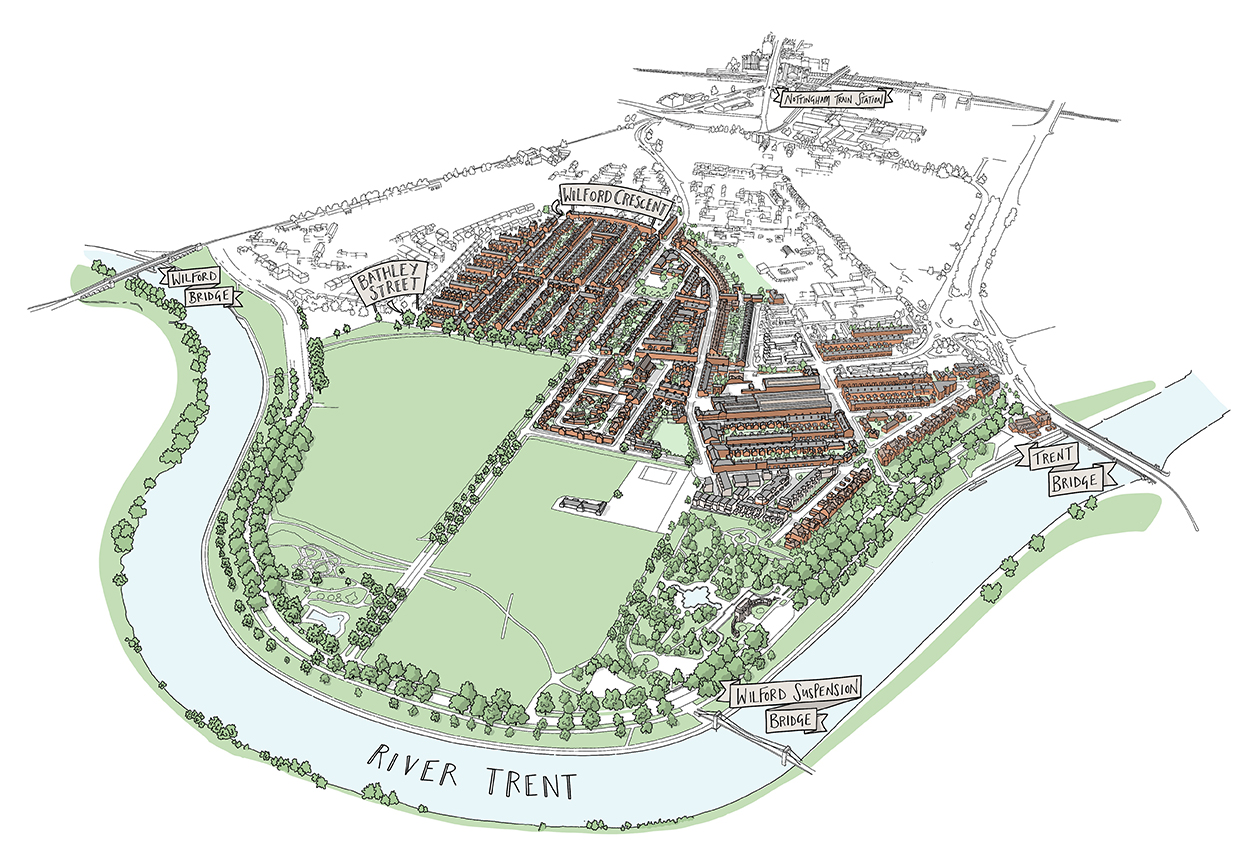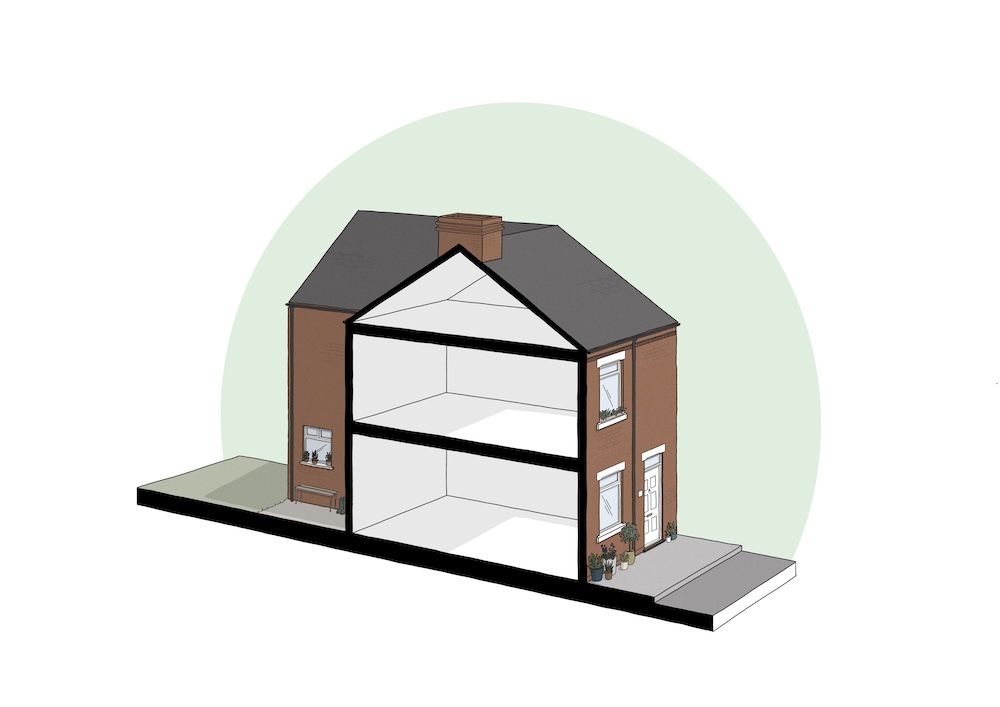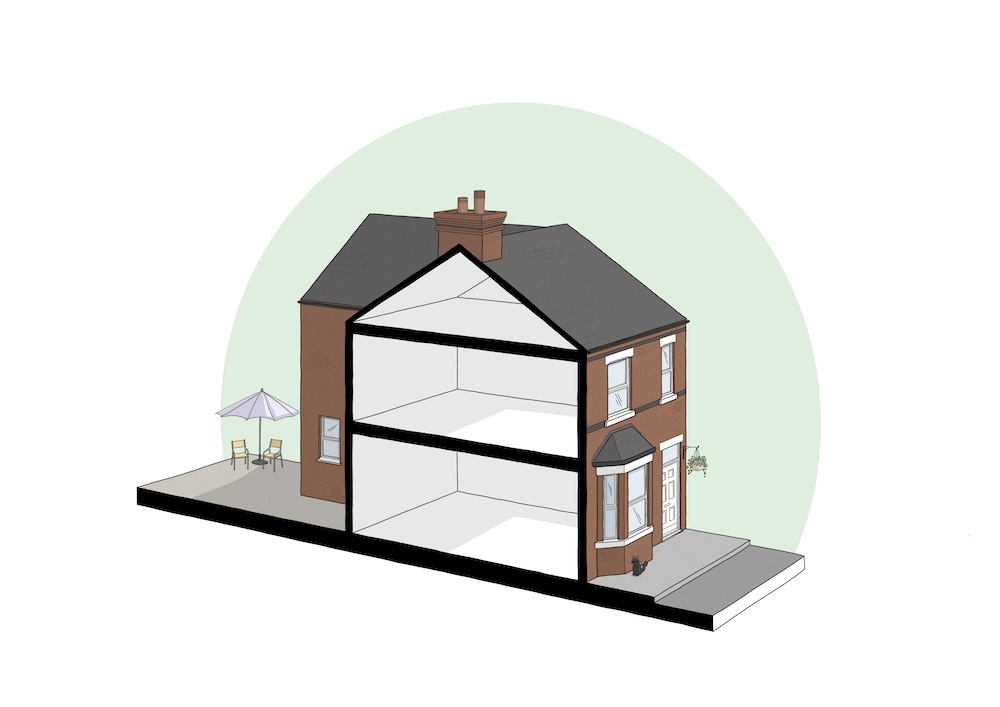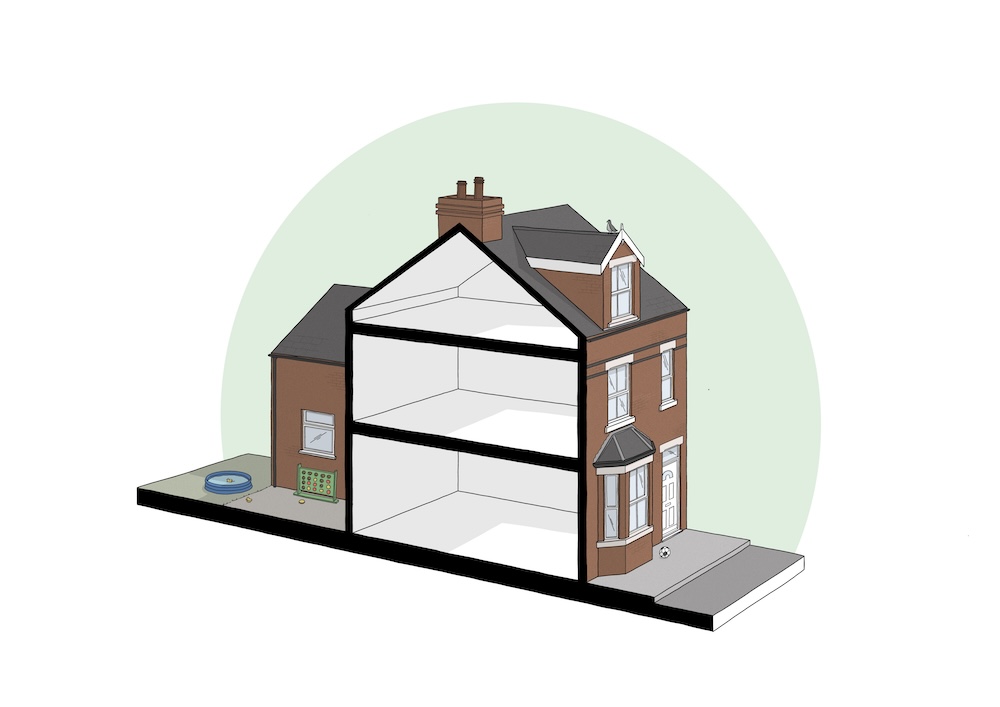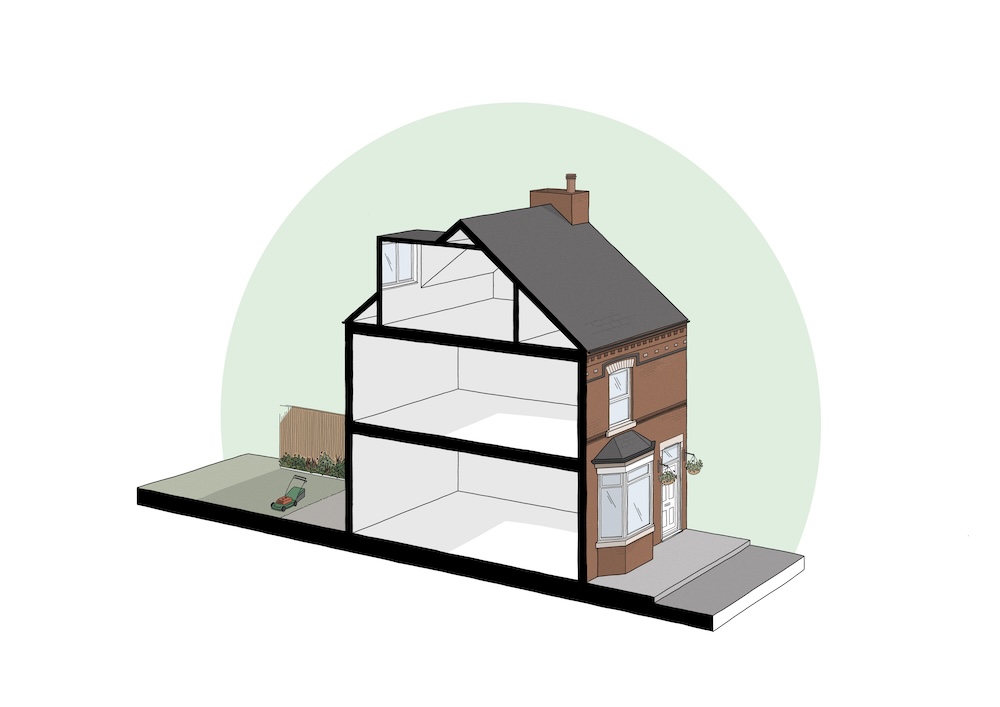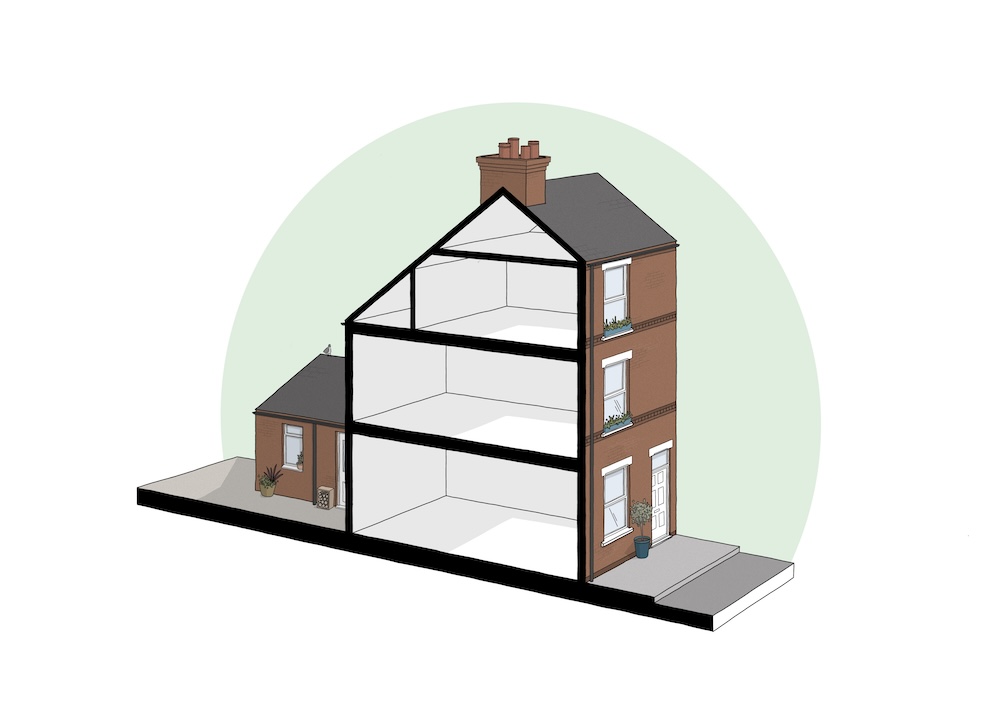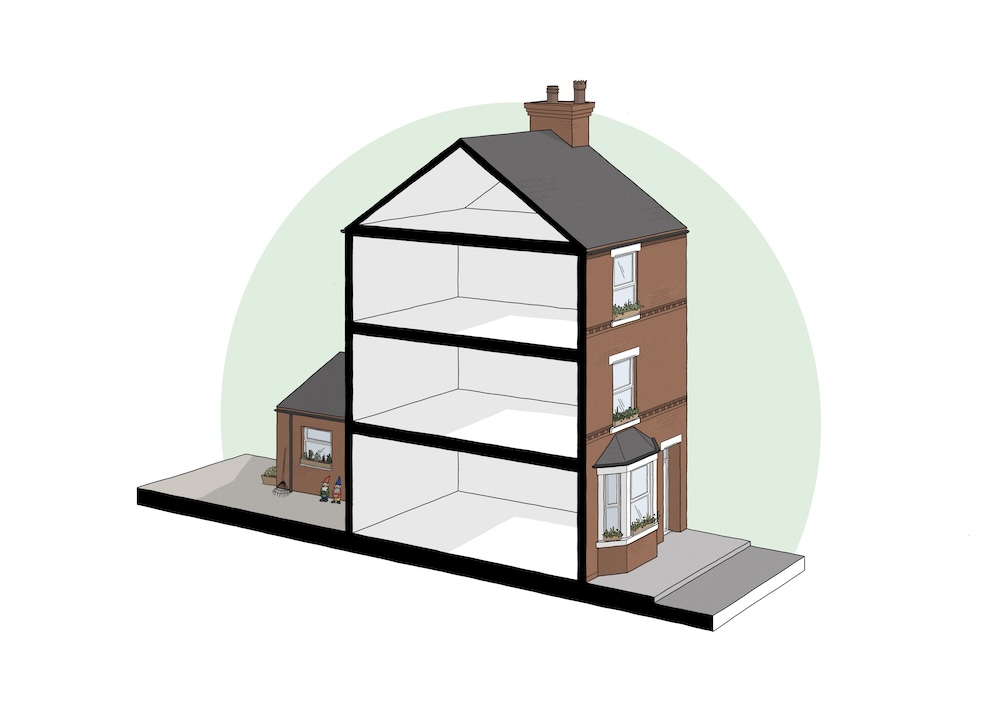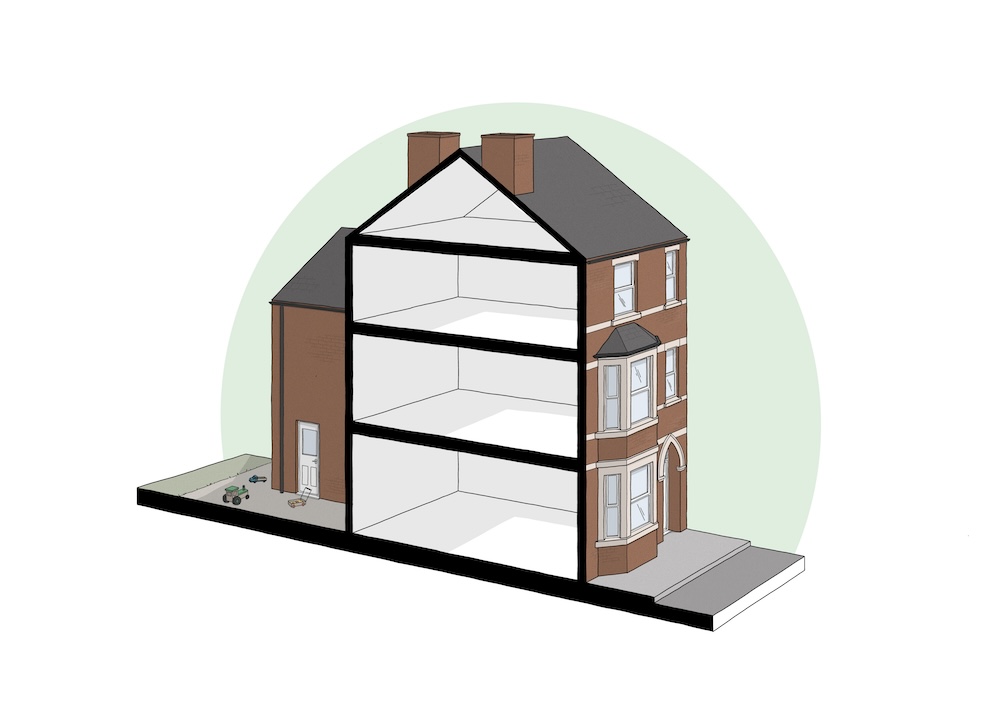About the Insulation Guide
The Old Meadows Conservation area contains some lovely examples of Victorian terrace homes and although beautiful, these homes are often leaky, draughty and expensive to heat.
The Insulation Guide has been created through surveying the existing buildings in the Old Meadows Conservation area (approximately 10%) through Green Meadows Future-Fit Homes scheme. By doing so, we have created personalised guides which tell you how to insulate your Victorian home. The guides include information on how to deal with tricky details (for example when your roof insulation meets the wall insulation).
The guide supports homeowners, landlords, architects, contractors and anybody involved in the retrofit process or interested in insulating Victorian homes.
The Meadows Victorian Archetypes
A two storey terrace with a rear addition
The Old Meadows Conservation area contains some lovely examples of Victorian terrace homes, although beautiful, these homes are often leaky, draughty and expensive to heat. We want to make sure that these homes are protected for future generations to enjoy and are also insulated to make sure that they are warmer and healthier homes for you and your family.
The annual estimated existing energy usage for this house is… 19,138 KWh
The annual proposed energy consumption could be… 3,145 KWh
Does this look like your house?
We have created personalised guides which tell you how to add insulation to your Victorian home. The guides include information on how to deal with common tricky details (for example where your roof insulation meets the wall insulation).
You may already have the skills to carry this work out on your own, but if not, this guide can also be given to your builder to show them how you want the work to be done. You can also attend one of our DIY Workshops or our Practical Introduction to Conservation Retrofit Course to learn some of the practical skills needed to carry out this work.
We also have a Green Meadows Toolshare where you can hire the tools you will need to insulate your home.
Create your personalised insulation guide nowA two storey terrace with a two storey addition and a bay window
The Old Meadows Conservation area contains some lovely examples of Victorian terrace homes, although beautiful, these homes are often leaky, draughty and expensive to heat. We want to make sure that these homes are protected for future generations to enjoy and are also insulated to make sure that they are warmer and healthier homes for you and your family.
The annual estimated existing energy usage for this house is… 23,971 KWh
The annual proposed energy consumption could be… 4,211 KWh
Does this look like your house?
We have created personalised guides which tell you how to add insulation to your Victorian home. The guides include information on how to deal with common tricky details (for example where your roof insulation meets the wall insulation).
You may already have the skills to carry this work out on your own, but if not, this guide can also be given to your builder to show them how you want the work to be done. You can also attend one of our DIY Workshops or our Practical Introduction to Conservation Retrofit Course to learn some of the practical skills needed to carry out this work.
We also have a Green Meadows Toolshare where you can hire the tools you will need to insulate your home.
Create your personalised insulation guide nowA terrace with a dormer and a bay window
The Old Meadows Conservation area contains some lovely examples of Victorian terrace homes, although beautiful, these homes are often leaky, draughty and expensive to heat. We want to make sure that these homes are protected for future generations to enjoy and are also insulated to make sure that they are warmer and healthier homes for you and your family.
The annual estimated existing energy usage for this house is… 17,874 KWh
The annual proposed energy consumption could be… 3,445 KWh
Does this look like your house?
We have created personalised guides which tell you how to add insulation to your Victorian home. The guides include information on how to deal with common tricky details (for example where your roof insulation meets the wall insulation).
You may already have the skills to carry this work out on your own, but if not, this guide can also be given to your builder to show them how you want the work to be done. You can also attend one of our DIY Workshops or our Practical Introduction to Conservation Retrofit Course to learn some of the practical skills needed to carry out this work.
We also have a Green Meadows Toolshare where you can hire the tools you will need to insulate your home.
Create your personalised insulation guide nowA terrace with two dormers in the roof and a bay window
The Old Meadows Conservation area contains some lovely examples of Victorian terrace homes, although beautiful, these homes are often leaky, draughty and expensive to heat. We want to make sure that these homes are protected for future generations to enjoy and are also insulated to make sure that they are warmer and healthier homes for you and your family.
The annual estimated existing energy usage for this house is… 21,407 KWh
The annual proposed energy consumption could be… 3,871 KWh
Does this look like your house?
We have created personalised guides which tell you how to add insulation to your Victorian home. The guides include information on how to deal with common tricky details (for example where your roof insulation meets the wall insulation).
You may already have the skills to carry this work out on your own, but if not, this guide can also be given to your builder to show them how you want the work to be done. You can also attend one of our DIY Workshops or our Practical Introduction to Conservation Retrofit Course to learn some of the practical skills needed to carry out this work.
We also have a Green Meadows Toolshare where you can hire the tools you will need to insulate your home.
Create your personalised insulation guide nowA three storeys with a bay window and a timber dormer at the back
The Old Meadows Conservation area contains some lovely examples of Victorian terrace homes, although beautiful, these homes are often leaky, draughty and expensive to heat. We want to make sure that these homes are protected for future generations to enjoy and are also insulated to make sure that they are warmer and healthier homes for you and your family.
The annual estimated existing energy usage for this house is… 27,206 KWh
The annual proposed energy consumption could be… 4,360 KWh
Does this look like your house?
We have created personalised guides which tell you how to add insulation to your Victorian home. The guides include information on how to deal with common tricky details (for example where your roof insulation meets the wall insulation).
You may already have the skills to carry this work out on your own, but if not, this guide can also be given to your builder to show them how you want the work to be done. You can also attend one of our DIY Workshops or our Practical Introduction to Conservation Retrofit Course to learn some of the practical skills needed to carry out this work.
We also have a Green Meadows Toolshare where you can hire the tools you will need to insulate your home.
Create your personalised insulation guide nowA three storeys with a catslide roof
The Old Meadows Conservation area contains some lovely examples of Victorian terrace homes, although beautiful, these homes are often leaky, draughty and expensive to heat. We want to make sure that these homes are protected for future generations to enjoy and are also insulated to make sure that they are warmer and healthier homes for you and your family.
The annual estimated existing energy usage for this house is… 22,300 KWh
The annual proposed energy consumption could be… 3,322 KWh
Does this look like your house?
We have created personalised guides which tell you how to add insulation to your Victorian home. The guides include information on how to deal with common tricky details (for example where your roof insulation meets the wall insulation).
You may already have the skills to carry this work out on your own, but if not, this guide can also be given to your builder to show them how you want the work to be done. You can also attend one of our DIY Workshops or our Practical Introduction to Conservation Retrofit Course to learn some of the practical skills needed to carry out this work.
We also have a Green Meadows Toolshare where you can hire the tools you will need to insulate your home.
Create your personalised insulation guide nowA three storeys with a single storey rear addition and a bay window
The Old Meadows Conservation area contains some lovely examples of Victorian terrace homes, although beautiful, these homes are often leaky, draughty and expensive to heat. We want to make sure that these homes are protected for future generations to enjoy and are also insulated to make sure that they are warmer and healthier homes for you and your family.
The annual estimated existing energy usage for this house is… 16,591 KWh
The annual proposed energy consumption could be… 2,118 KWh
Does this look like your house?
We have created personalised guides which tell you how to add insulation to your Victorian home. The guides include information on how to deal with common tricky details (for example where your roof insulation meets the wall insulation).
You may already have the skills to carry this work out on your own, but if not, this guide can also be given to your builder to show them how you want the work to be done. You can also attend one of our DIY Workshops or our Practical Introduction to Conservation Retrofit Course to learn some of the practical skills needed to carry out this work.
We also have a Green Meadows Toolshare where you can hire the tools you will need to insulate your home.
Create your personalised insulation guide nowA three storeys with a two storey rear addition and a two storey bay window
The Old Meadows Conservation area contains some lovely examples of Victorian terrace homes, although beautiful, these homes are often leaky, draughty and expensive to heat. We want to make sure that these homes are protected for future generations to enjoy and are also insulated to make sure that they are warmer and healthier homes for you and your family.
The annual estimated existing energy usage for this house is… 29,456 KWh
The annual proposed energy consumption could be… 3,937 KWh
Does this look like your house?
We have created personalised guides which tell you how to add insulation to your Victorian home. The guides include information on how to deal with common tricky details (for example where your roof insulation meets the wall insulation).
You may already have the skills to carry this work out on your own, but if not, this guide can also be given to your builder to show them how you want the work to be done. You can also attend one of our DIY Workshops or our Practical Introduction to Conservation Retrofit Course to learn some of the practical skills needed to carry out this work.
We also have a Green Meadows Toolshare where you can hire the tools you will need to insulate your home.
Create your personalised insulation guide now
Willford Bridge Toll House
Wilford Bridge Toll House is a Grade II listed building built in 1870 by EW Hughes. Toll houses used to have living space in them for a toll collector who would charge people for crossing the bridge. The building is red brick, typical of the Old Meadows and Nottingham. You can see a ticket window where the toll collector would have sat. The pointed arched windows are ornate and the lead clad dormers are typical of a Gothic Revival style. Above the door there is a toll board dating from 1826!
More Information
Trent Bridge
Connecting the Meadows to West Bridgeford the Trent Bridge was built from 1868-71 by Corporation Engineer, M Ogle Tarbotton and is of Gothic Revival style. There are many examples of Gothic Revival in Nottingham, including the majestic St. Barnabas Cathedral in the city centre. The cast-iron part of the bridge was designed by Andrew Handyside from Derby. The bridge is Grade 2 listed.
More Information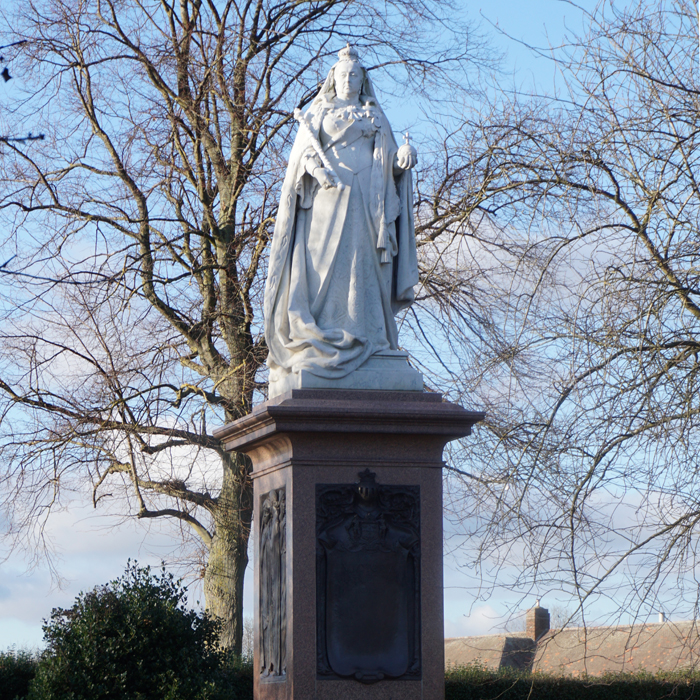
Statue Of Queen Victoria In Memorial Gardens
This memorial statue by Albert Toft used to sit in the Market Place in the city centre of Nottingham. It was originally made in 1905 to it is made of white marble and is Grade II listed, it was later moved to the Meadows Memorial Garden. During the reign of Queen Victoria, the Meadows, and the whole of Nottingham, went through a huge period of change due to an expansion of industry.
More Information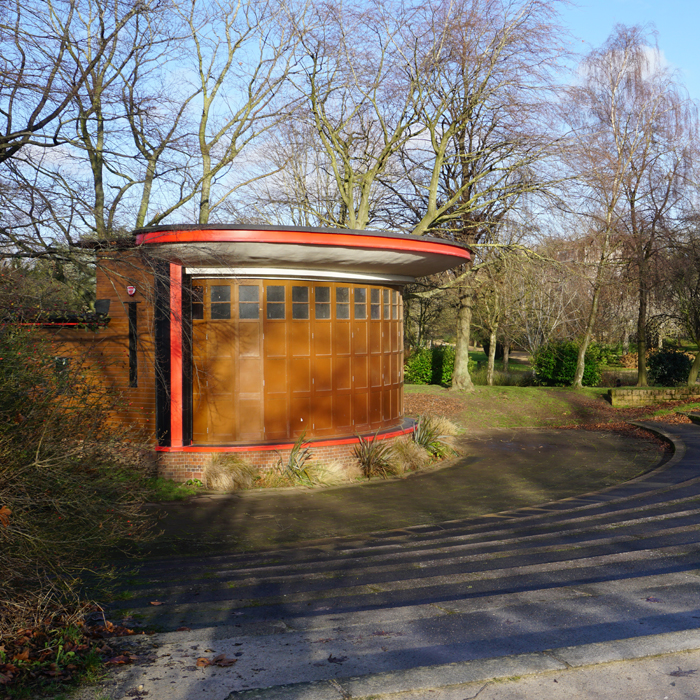
Bandstand
Built in 1937 the Meadows Bandstand is Grade 2 listed. It was very progressive at the time it was built and was seen as very modern and bold design. Many other bandstands built at the time were mass produced copies. It is thought that the Architect was taught by the famous Walter Gropius before going to work for the Nottingham Corporation Architects Department.
More Information
Nottingham Municipal War Memorial
The city's Grade II listed war memorial is a large arched structure in the Meadows and overlooks the river built in 1927. It was first built to commemorate those who died in the first world war and then a plaque was added to commemorate the lives lost in World War II. The memorial shows the huge role the city of Nottingham played in both war efforts.
More Information
Former Trent Bridge Tram Depot
The Trent Bridge Tram Depot was built for the electric trams which were first introduced to the city in 1883. This electric tram system replaced the horse drawn trams which came before. The building was built as a car house and repair shop, completed in 1901. Arthur Brown, the City Engineer lead the construction and engineering work to the depot. The main depot building was big enough to house 80-90 cars however, the depot was much more than just storage and contained space for a number of different functions including a black-smiths, coal shed and recreation space.
More Information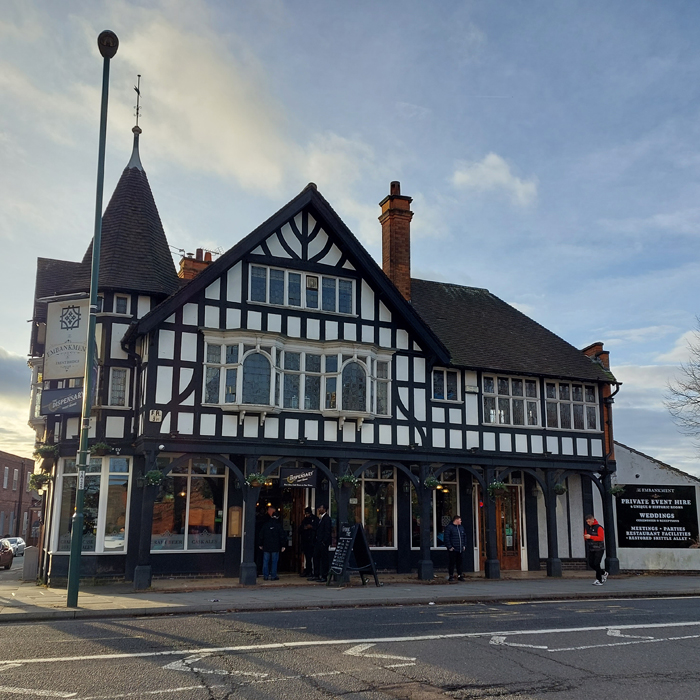
The Embankment
The Embankment pub is a former Boots shop, subscription library and tearoom. A.N. Bromley designed the building in a Tudor style although it was built in 1905-07. Inside it is more akin to the Edwardian Arts and Crafts movement of the time with fine craftsmanship and good quality materials. It was the second ever Boots store and it is evidence of the success of the local business.
More Information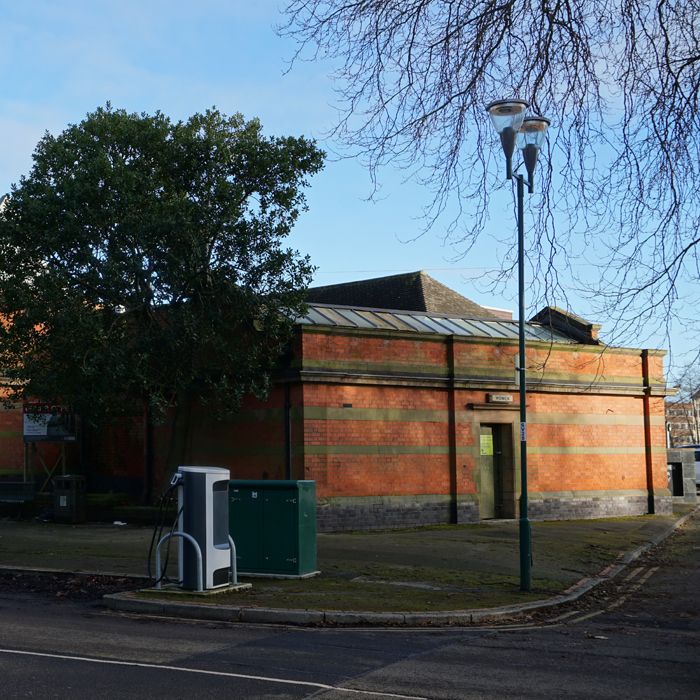
Public Conveniences
These unassuming structures were once well used public toilets and a key piece of Victorian infrastructure. The interiors of the buildings remain intact with glazed tiles and a lanterned roof. On the outside there is still ornate tiling and original cast iron rainwater goods. The toilets have been closed to the public since 2006.
More Information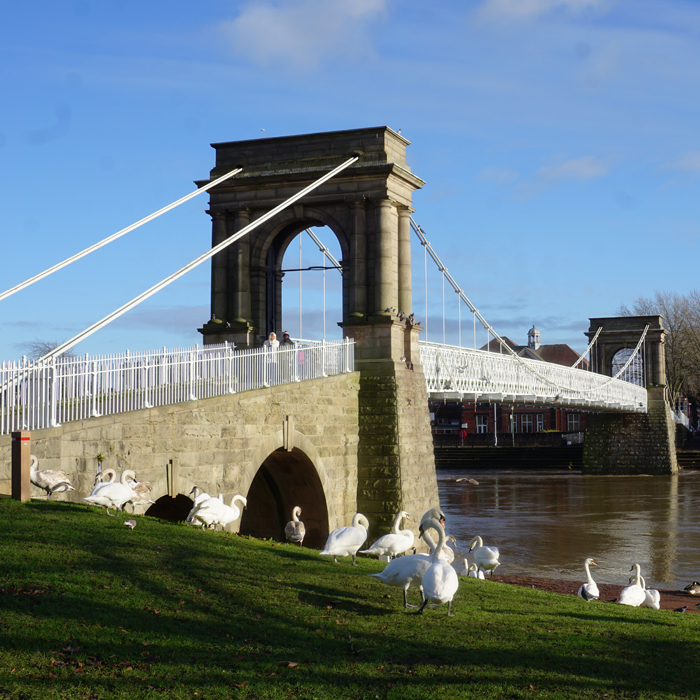
Wilford Suspension Bridge
Wilford Suspension footbridge. Was built in 1906 from a type of wood called ashlar, and steel. It was built by Nottingham Corporation Water Department who were responsible for the city’s water supply at the time. The main reason that the bridge was built was to carry mains water underneath the footpath to the city from an old reservoir which used to sit on Wilford Hill.
More Information
Statue of Sir Robert Juckes Clifton
Sir Robert Dukes Clifton was a popular figure in Nottingham, he funded the Wilford Toll Bridge which sits be-side this statue. His family were landowners local to Nottinghamshire since the Middle Ages and their estate was Clifton Hall. He was a Member of Parliament for Nottingham who was so popular that when he died in 1869, 20,000 people attended his funeral in Clifton.
More Information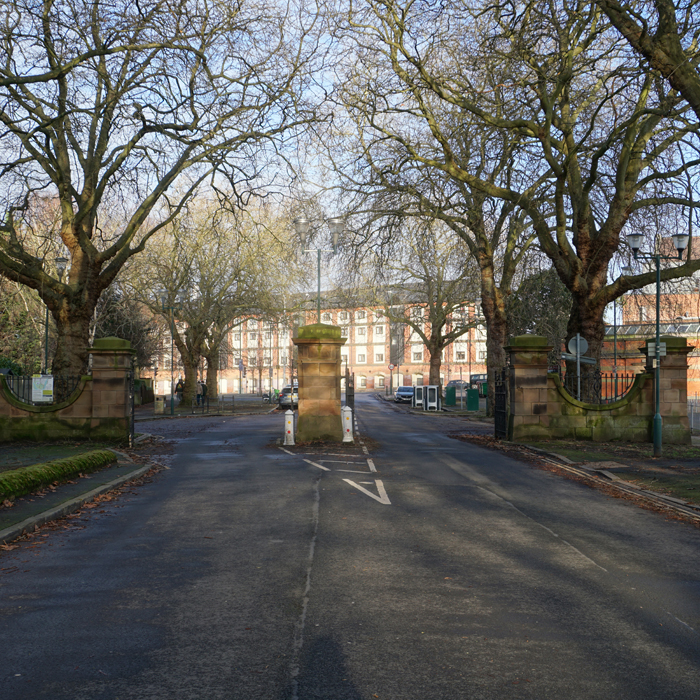
Embankment Gateway
The gateways to the Embankment are Grade II listed and mark either end of the Meadows Recreation Ground. Victoria Embankment was built between 1898 and 1901. It extends for 10 miles of concrete steps, 7/5 miles of fencing and 150 places to sit!
More Information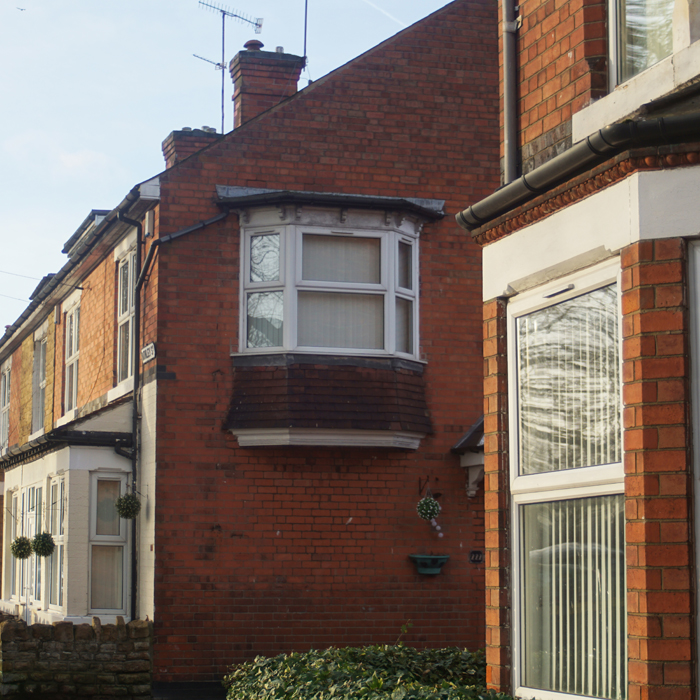
Bathley Street
Bathley Street, has examples of ornate Victorian details, typical of the Old Meadows. These would have been sought after homes as they are in a desirable position overlooking Victoria Embankment. The features on the houses are typical of Nottingham’s development during the Victorian period. The bay windows, stone mullions, arched doorways and decorative brick banding are all evidence of typical Victorian detailing, design and craftsmanship.
More Information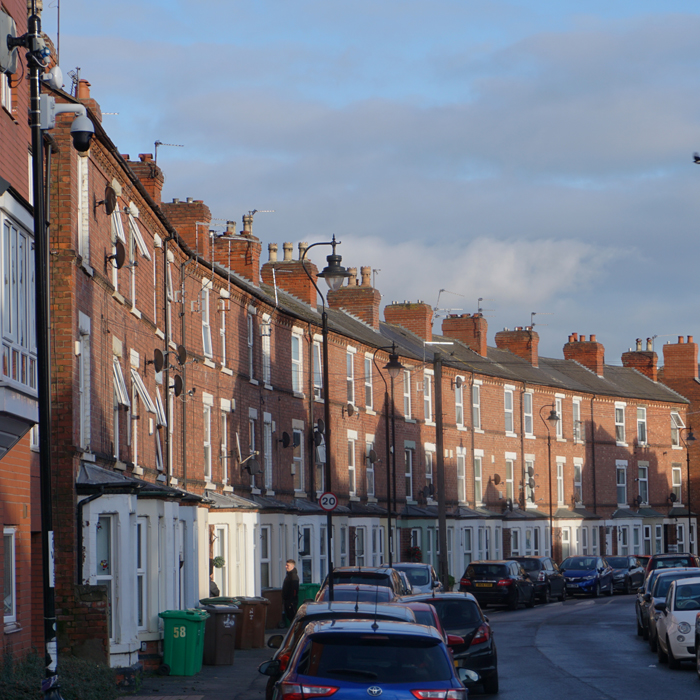
Wilford Crescent West
The Victorian buildings of Wilford Crecent originally curved round to the West but huge sections of the Meadows were demolished in 1970s to make way for new development.

Wilford Crescent East
Wilford Crescent West is a key feature of the Old Meadows and a lovely example of Victorian Town Planning. Wilford Crescent, is an interesting anomaly because it breaks away from the tight, straight streets which maximised density. The road’s ‘crescent’ formation was more commonly associated with high status mansions of the late Georgian period and would have been more expensive to build. In fact, Wilford Crescent sits on an old land drain which seems to have dictated the lay-out of Wilford Crescent and its gentle arc formation of terraced housing, which remains one of the most elegant features of the conservation area.
Why is it important?
By insulating the right way, we're making Victorian homes warmer and healthier for their current residents while protecting them for future generations.
There are risks to retrofitting Victorian homes and there are many examples where the home has been made worse by poorly installed insulation measures.
We want to strike a balance between improving the energy efficiency of the building and protecting the Victorian features of the building.
In the face of climate change and high energy costs, it is crucial that we take action to improve the energy efficiency of these buildings, aiming to lower carbon, improve comfort and lower living costs.
The Insulation Guide mobilises this movement by empowering the Meadows community with the knowledge to get started. Together, we're working towards a greener future.
About the Green Meadows Project
Local action on climate change
The Green Meadows Project empowers the Meadows community to act together on climate change. The project offers practical learning, training and advice to build momentum and make lasting changes.
The Green Meadows Project tackles climate changes across 3 strands:



